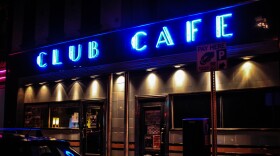On the corner of Penn Avenue and Seventh Street in downtown Pittsburgh, there’s a blue and gold plaque that reads “The Pittsburgh Agreement.”
The sign and what it represents was on the mind of Good Question listener Mindi Schompert, who asked,
This is part of our Good Question! series where we investigate what you've always wondered about Pittsburgh, its people and its culture.
“Why was the Pittsburgh Agreement signed in Pittsburgh?”
But the document has very little to do with the Steel City.
It pays homage to the cultural preservation of two countries, Slovakia and the Czech Republic. The Pittsburgh Agreement ensured the formation of Czechoslovakia, the combined country of the two small eastern European nations.
“I was familiar with the agreement itself,” said Schompert, whose grandmother was a Slovak immigrant to western Pennsylvania. “But I never knew why exactly here, in Pittsburgh.”
Slovak culture is everywhere in the Steel City. It's home to the Honorary Slovak Consulate, a handful of social clubs, cultural centers and annual holiday festivals dedicated to maintaining and celebrating Slovak traditions.

“Allegheny County has the highest percentage of all of the counties in the United States, not just Pennsylvania, of people who claim Slovak heritage,” said Martin Votruba, head of Slavic studies at the University of Pittsburgh.
According to census data, Western Pennsylvania has a huge population of Slovak-Americans, more than any other region in the country. It's evident in the city’s cuisine, from haluski to lokse, all originally Slovak dishes.
So how did people from this small eastern European country end up in Pittsburgh?
Around the turn of the 20th century, an estimated half million Slovakians immigrated to the U.S., most settling in Pennsylvania to work in the coal mines and steel industry. With the onset of World War I, the boundaries in Europe started to change. Slovakia was part of the Central powers, and it looked like they weren’t going to win.
Back in the states, Slovak immigrants took action.
“The Slovak Americans and Czech Americans got together,” Votruba said. “And they pushed Washington and London and Paris and Rome to actually create a new country for themselves together.”

Votruba said Slovaks and Czechs wanted to combine their countries, because it would help protect their culture. They didn’t want to become assimilated by the Central powers of Germany, Austria and Hungary.
“Because Czech and Slovak are very close to each other, the idea was to liberate themselves from the pressure of ‘Germanization’ and ‘Hungarianization’ that was going on,” Votruba said.

Slovaks and Czechs formed a group called the Czecho-Slovak National Council of America. Because there were so many Slovak immigrants living in Pittsburgh, Votruba said it seemed like the perfect location to have a big meeting on Memorial Day in 1918.
“Downtown Pittsburgh was crowded with Slovaks!” Vortruba said. “Mostly Slovaks, actually. Pittsburgh doesn’t have too many Czech immigrants, [so] it was mostly Slovak immigrants, but Czechs were part of the arrangement. They came from other parts.”
Leaders from both countries met to discuss the new country they’d create, Czechoslovakia. Among the attendees was a man named Tomáš Garrigue Masaryk, a Czech politician who would later become the newly combined country’s first president.
“He had a good idea of how to organize a country,” Votruba said. “He was instrumental.”
At the meeting, it was agreed that there wouldn’t be one national language and that, unlike under the Central powers, the government would be a democracy.
“Czechoslovakia ended up being a fairly democratic country when Europe was going fascist, totalitarian,” Votruba said. “It was among the only countries that remained reasonably democratic before WWII began.”
More than two dozen Czech and Slovak delegates signed the agreement at what was then the Loyal Order of Moose building Downtown. Not long after, the U.S. and its allies recognized Czechoslovakia as a sovereign nation.
Votruba said Slovak and Czech people were big fans of the Allies, despite their historical alignment with the nations that comprised the Central powers.
“[President Woodrow] Wilson was so popular that the capital of Slovakia, which is Bratislava now, originally they were thinking of calling it Wilson City,” Votruba said.
It stayed unified throughout World War II when it was taken over by Russia. Votruba said it wasn’t until 1989, when communism fell, that Czechoslovakia split and became the Czech Republic and Slovakia.

“There was no animosity, there was no fighting. They are still each other’s favorite nations in central Europe,” said Votruba.
He said because the two countries were willing to join forces during uncertain political times, it actually helped them maintain their individual cultural identities.
Want to learn more? The University of Pittsburgh Slavic Studies program will hold their annual Slovak Heritage Festival this weekend at the Cathedral of Learning in Oakland.














